The Intel Xeon W-3175X Review: 28 Unlocked Cores, $2999
by Ian Cutress on January 30, 2019 9:00 AM ESTCPU Performance: Office Tests
The Office test suite is designed to focus around more industry standard tests that focus on office workflows, system meetings, some synthetics, but we also bundle compiler performance in with this section. For users that have to evaluate hardware in general, these are usually the benchmarks that most consider.
All of our benchmark results can also be found in our benchmark engine, Bench.
For our graphs, some of them have two values: a regular value in orange, and one in red called 'Intel Spec'. ASUS offers the option to 'open up' the power and current limits of the chip, so the CPU is still running at the same frequency but is not throttled. Despite Intel saying that they recommend 'Intel Spec', the system they sent to us to test was actually set up with the power limits opened up, and the results they provided for us to compare to internally also correlated with that setting. As a result, we're providing both sets results for our CPU tests.
PCMark 10: Industry Standard System Profiler
Futuremark, now known as UL, has developed benchmarks that have become industry standards for around two decades. The latest complete system test suite is PCMark 10, upgrading over PCMark 8 with updated tests and more OpenCL invested into use cases such as video streaming.
PCMark splits its scores into about 14 different areas, including application startup, web, spreadsheets, photo editing, rendering, video conferencing, and physics. We post all of these numbers in our benchmark database, Bench, however the key metric for the review is the overall score.
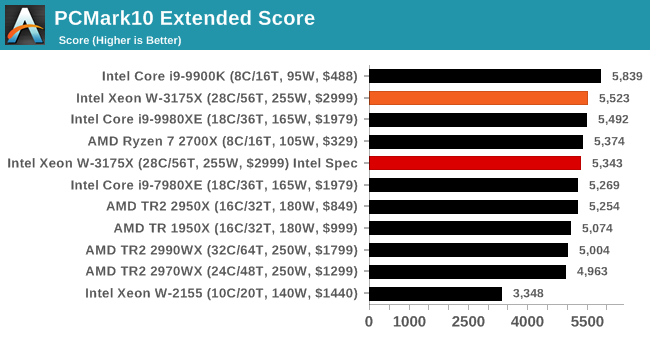
.
Chromium Compile: Windows VC++ Compile of Chrome 56
A large number of AnandTech readers are software engineers, looking at how the hardware they use performs. While compiling a Linux kernel is ‘standard’ for the reviewers who often compile, our test is a little more varied – we are using the windows instructions to compile Chrome, specifically a Chrome 56 build from March 2017, as that was when we built the test. Google quite handily gives instructions on how to compile with Windows, along with a 400k file download for the repo.
In our test, using Google’s instructions, we use the MSVC compiler and ninja developer tools to manage the compile. As you may expect, the benchmark is variably threaded, with a mix of DRAM requirements that benefit from faster caches. Data procured in our test is the time taken for the compile, which we convert into compiles per day.
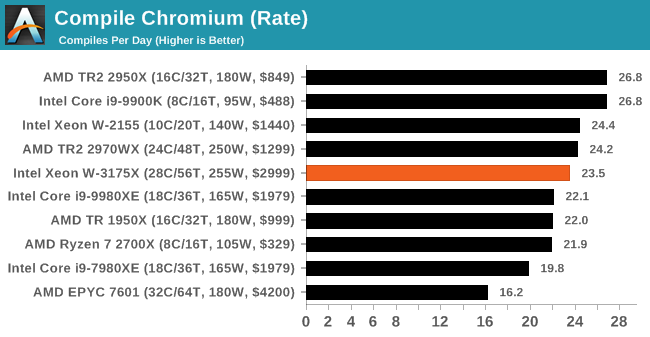
.
3DMark Physics: In-Game Physics Compute
Alongside PCMark is 3DMark, Futuremark’s (UL’s) gaming test suite. Each gaming tests consists of one or two GPU heavy scenes, along with a physics test that is indicative of when the test was written and the platform it is aimed at. The main overriding tests, in order of complexity, are Ice Storm, Cloud Gate, Sky Diver, Fire Strike, and Time Spy.
Some of the subtests offer variants, such as Ice Storm Unlimited, which is aimed at mobile platforms with an off-screen rendering, or Fire Strike Ultra which is aimed at high-end 4K systems with lots of the added features turned on. Time Spy also currently has an AVX-512 mode (which we may be using in the future).
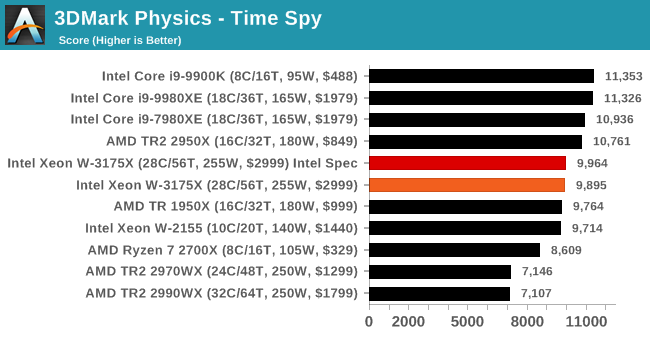
.
GeekBench4: Synthetics
A common tool for cross-platform testing between mobile, PC, and Mac, GeekBench 4 is an ultimate exercise in synthetic testing across a range of algorithms looking for peak throughput. Tests include encryption, compression, fast Fourier transform, memory operations, n-body physics, matrix operations, histogram manipulation, and HTML parsing.
I’m including this test due to popular demand, although the results do come across as overly synthetic, and a lot of users often put a lot of weight behind the test due to the fact that it is compiled across different platforms (although with different compilers).
We record the main subtest scores (Crypto, Integer, Floating Point, Memory) in our benchmark database, but for the review we post the overall single and multi-threaded results.
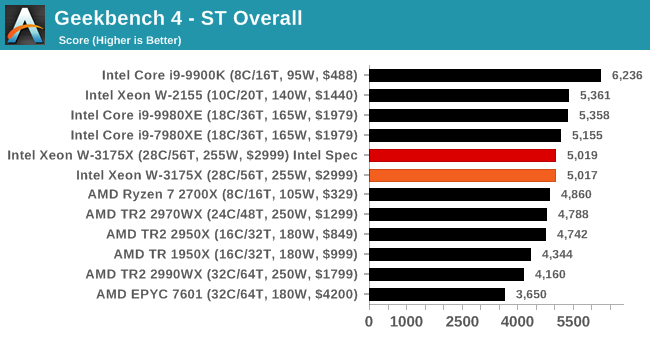
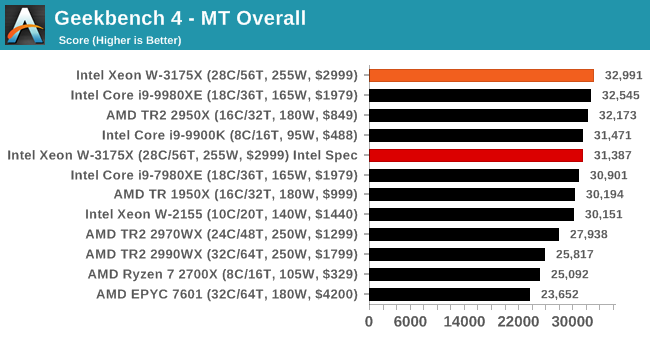










136 Comments
View All Comments
abufrejoval - Wednesday, January 30, 2019 - link
So with the limited edition production numbers, quite clearly the price can be symbolically low, just so Intel can claim bragging rights: They are not interested in satisfying market demands, especially since far too many workstation and server customers might switch over from a Xeon Scalable offering, they just want to claim victory... everywhere... including 10nmJust pathetic!
And honestly, you shouldn't even report about it. Your mission is to inform consumers on products they can buy. If consumers cannot buy it, you should treat it very, very differently, if at all.
You're just being abused by Intel to push a brand that suffers for reasons.
SH3200 - Wednesday, January 30, 2019 - link
This product cannibalizes half the current Xeon lineup as it provides ecc/rdimm at a fraction of the cost. I’d be amazed if FSI customers don’t prebuy every single one ever made before it even hits the public.br83taylor - Wednesday, January 30, 2019 - link
I find it odd Ian is happy to run and report benchmarks with this processor going against Intel recommendation for bios settings, yet would not do it for the AMD processors with their PBO setting. Both of which seem to do very similar things. Letting the 2990WX run with PBO would give it a much fairer chance against this.GreenReaper - Thursday, January 31, 2019 - link
It's not unressonablr to test the system as given to you, especially when it is provided as a complete system, so may represent what end-users get. That said, it seems like he kinda called that out in the sideways manner by highlighting the fact that the system Intel had shipped to him was not actually using those specifications.outsideloop - Wednesday, January 30, 2019 - link
This reminds me of the FX-9590. Massively overclocking silicon to keep up. Except now, the shoe is on the other foot.wow&wow - Wednesday, January 30, 2019 - link
Xeon W-3175X: $2999+$1500= $4499Ryzen TR 2900WX: $1799+$300= $2099
Is Intel trying to market it for “stupids” or those whose left brains being not right and right brains having nothing left :-D
ksec - Wednesday, January 30, 2019 - link
I think we need some new innovation in Thermal Cooling, how we could cool more with less, ease and cheaper. We pushed to near 600W for CPU and GPU alone.mapesdhs - Saturday, February 2, 2019 - link
Ye cannae beat the laws of physics. :D Thermal density is a hard problem. Check out AdoredTV's video on the subject, it explains things nicely.The_Assimilator - Wednesday, January 30, 2019 - link
This is Pentium 4 days all over again.bananaforscale - Thursday, January 31, 2019 - link
Kitty approves of heat output.